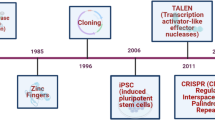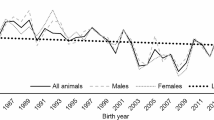Abstract
Prolactin (PRL) plays a crucial role in the initiation and maintenance of lactation in mammals. In this study, seven PCR fragments representing most important functional domains of PRL gene were screened for single nucleotide polymorphisms (SNPs) in Chinese Holsteins by single-strand conformation polymorphisms and amplicons sequencing, and their genetic effects on milk production traits were evaluated. A total of four SNPs, including two in the promoter (−1043A>G and −402A>G), one in intron 1 (+2723C>T) and one in exon 4 (+8398G>A) were identified in PRL gene. Statistical results showed significant associations between the promoter genotypes and the milk performance traits in Chinese Holsteins. Cows with genotype P1-GG showed higher milk yields (P < 0.01), while cows with genotype P1-AA showed higher fat contents (P < 0.01). Haplotype analysis of two SNPs in promoter region revealed that the Hap(AG) was significantly associated with increased milk yields and Hap(AA) was associated with increased fat contents (P < 0.01). This is the second study reporting SNPs in the 5′-regulatory region of PRL gene, which interfere with milk production traits.

Similar content being viewed by others
References
Perrot-Applanat M, Gualillo O, Pezet A, Vincent V, Edery M, Kelly PA (1997) Dominant negative and cooperative effects of mutant forms of prolactin receptor. Mol Endocrinol 11:1020–1032
Bole-Feysot C, Goffin V, Edery M, Binart N, Kelly PA (1998) Prolactin (PRL) and its receptor: actions, signal transduction pathways and phenotypes observed in PRL receptor knockout mice. Endocr Rev 19:225–268
Goffin V, Binart N, Clement-Lacroix P, Bouchard B, Bole-Feysot C, Edery M et al (1999) From the molecular biology of prolactin and its receptor to the lessons learned from knockout mice models. Genet Anal 15:189–201
Ormandy CJ, Naylor M, Harris J, Robertson F, Horseman ND, Lindeman GJ et al (2003) Investigation of the transcriptional changes underlying functional defects in the mammary glands of prolactin receptor knockout mice. Recent Prog Horm Res 58:297–323
Cao X, Wang Q, Yan JB, Yang FK, Huang SZ, Zeng YT (2002) Molecular cloning and analysis of bovine prolactin full-long genomic as well as cDNA sequences. Acta Genetica Sinica 29:768–773
Chung ER, Rhin TJ, Han SK (1996) Association between PCR RFLP markers of growth hormone and prolactin genes and production traits in dairy cattle. Korean J Anim Sci 38:321–336
Udina IG, Turkova SO, Kostuchenko MV, Lebedeva LA, Sulimova GE (2001) Polymorphism of bovine prolactin gene, microsatellites, PCR–RFLP. Russ J Genet 4:407–411
Dybus A (2002) Associations of growth hormone GH and prolactin PRL genes polymorphism with milk production traits in Polish Black and White cattle. Anim Sci Pap Rep 20:203–212
Nasrin G, Mohammad Z, Ghodratollah R, Seyed HH (2009) Associations between prolactin gene polymorphism and milk production in montebeliard cows. Int J Genet Mol Biol 1:48–51
Brym P, Kaminski S, Wojcik E (2005) Nucleotide sequence polymorphism within exon 4 of the bovine prolactin gene and its associations with milk performance traits. J Appl Genet 45:179–185
Chen H, Leibenguth F (1995) Restriction endonuclease analysis of mitochondrial DNA of three farm animal species cattle, sheep and goat. Comp Biochem Physiol B Biochem Mol Biol 111:643–649
Orita M, Iwahana H, Kanazawa H, Hayashi K, Sekiya T (1989) Detection of polymorphisms of human DNA by gel electrophoresis as single-strand conformation polymorphisms. Proc Natl Acad Sci 86:2766–2770
Jiang RS, Xu GY, Zhang XQ, Yang N (2005) Association of polymorphisms for prolactin and prolactin receptor genes with broody traits in chickens. Poult Sci 84:839–845
Chu MX, Wang XC, Jin M, Di R, Chen HQ, Zhu GQ et al (2009) DNA polymorphism of 5′ flanking region of prolactin gene and its association with litter size in sheep. J Anim Breed Genet 126:63–68
Auchtung TL, Rius AG, Kendall PE, McFadden TB, Dahl GE (2005) Effects of photoperiod during the dry period on prolactin, prolactin receptor, and milk production of dairy cows. J Dairy Sci 88:121–127
Maurer RA, Notides AC (1987) Identification of an estrogen responsive element from the 5′-flanking region of the rat prolactin gene. Mol Cell Biol 7:4247–4254
Joudrey EM, Lechniak D, Petrik J, King WA (2003) Expression of growth hormone and its transcription factor, Pit-1, in early bovine development. Mol Reprod Dev 64:275–283
Enwright JF, Kawecki-Crook MA, Voss TC, Schaufele F, Day RN (2003) A PIT-1 homeodomain mutant blocks the intranuclear recruitment of the CCAAT/enhancer binding protein alpha required for prolactin gene transcription. Mol Endocrinol 17:209–222
Hart GL, Bastiaansen J, Dentine MR, Kirkpatrick BW (1993) Detection of a four-allele single strand conformation polymorphism (SSCP) in the bovine prolactin gene 5′ flank. Anim Genet 24:149
Brym P, Malewski T, Starzyński R, Flisikowski K, Wójcik E, Ruść A et al (2007) Effect of new SNP within bovine prolactin gene enhancer region on expression in the pituitary gland. Biochem Genet 45:743–754
Zhang HM, DeNise SK, Ax RL (1994) Diallelic single stranded conformational polymorphism detected in the bovine prolactin gene. J Anim Sci 72:256
Acknowledgments
This study was supported by the National 863 Program of China (No. 2006AA10Z197), National Natural Science Foundation of China (No. 30800847), National Key Technology R&D Program (No. 2006BAD01A10-5), Natural Science Foundation for Colleges and Universities in Jiangsu Province (No. 08KJD240002), The Key Discipline Fund of Jiangsu Province (No. SYC0703), Sustaining Program for Topnotch Persons of Northwest A&F University (No. 01140101), and Natural Science Foundation of Xuzhou Normal University (No. KY2007042), and Qinglan Project of Jiangsu Province. We would like to acknowledge current and former members of our laboratory for their valuable contributions and discussions.
Author information
Authors and Affiliations
Corresponding author
Additional information
Aijun Lü, Xiucai Hu have contributed equally to this work.
Rights and permissions
About this article
Cite this article
Lü, A., Hu, X., Chen, H. et al. Single nucleotide polymorphisms in bovine PRL gene and their associations with milk production traits in Chinese Holsteins. Mol Biol Rep 37, 547–551 (2010). https://doi.org/10.1007/s11033-009-9762-5
Received:
Accepted:
Published:
Issue Date:
DOI: https://doi.org/10.1007/s11033-009-9762-5




